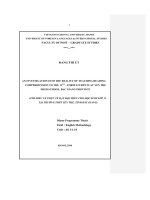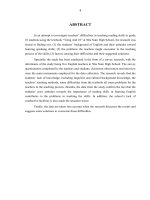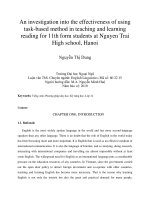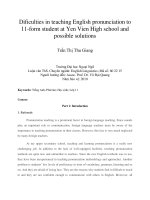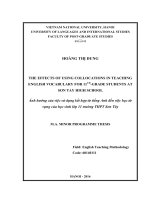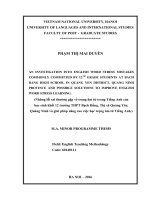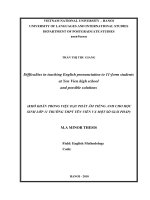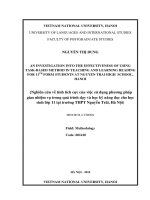An investigation into the reality of teaching reading comprehension to 11th - Form students at Yen The High school, Bacgiang province = Tìm hiểu về thực tế dạy
Bạn đang xem bản rút gọn của tài liệu. Xem và tải ngay bản đầy đủ của tài liệu tại đây (1.81 MB, 74 trang )
1
VIETNAM NATIONAL UNIVERSITY, HANOI
UNIVERSITY OF FOREIGN LANGUAGES & INTERNATIONAL STUDIES
FACULTY OF POST – GRADUATE STUDIES
***---***
ĐANG THI UT
AN INVESTIGATION INTO THE REALITY OF TEACHING READING
COMPREHENSION TO THE 11TH – FORM STUDENTS AT YEN THE
HIGH SCHOOL, BAC GIANG PROVINCE
(TÌM HIỂU VỀ THỰC TẾ DẠY ĐỌC HIỂU CHO HỌC SINH LỚP 11
TẠI TRƯỜNG THPT YÊN THẾ, TỈNH BẮC GIANG)
Minor Programme Thesis
Field : English Methodology
Code : 60. 14. 10
HANOI, 2010
4
TABLE OF CONTENTS
ACKNOWLEDGEMENTS… ............................................................................................ .i
ABSTRACT....................................................................................................................... ...ii
TABLE OF CONTENTS……………… .. ……………………………………………….iii
LIST OF ABBREVIATIONS………………………………………….……… ............... vi
LIST OF TABLES………………………………………… ............................................. vii
CHAPTER I: INTRODUCTION…………………………… .......................................... .1
1.1. Statement of the problems… ................................................................................... 1
1.2. Aims of the study and research questions……… ............................................... …2
1.3. Scope of the study.................................................................................................... 3
1.4. Outline of the thesis… ............................................................................. …………3
CHAPTER II: LITERATURE REVIEW………………… ............................................. 4
2.1. Reading and reading comprehension………………… ....................................... …4
2.1.1. Definitions ....................................................................................................... 4
2.1.2. Kinds of reading .............................................................................................. 5
2.1.2.1. Reading aloud..................................................................................... 5
2.1.2.2. Silent reading .................................................................................... .6
2.1.2.3. Skimming ........................................................................................... .6
2.1.2.4. Scanning ............................................................................................ .6
2.1.2.5. Intensive reading ................................................................................ 7
2.1.2.6. Extensive reading ............................................................................... 7
2.2. The teaching of reading ........................................................................................... 7
2.2.1. Factors in teaching and learning reading ...................................................... .7
2.2.1.1. Teacher’s roles in teaching reading……………………………………..7
2.2.1.2. Students’ roles in a reading lesson……………………………………...8
2.2.1.3. The roles of reading texts……………………………………..…..8
2.2.2. Stages of teaching a reading lesson .............................................................. .9
2.2.2.1. Pre- reading stage ............................................................................. .9
2.2.2.2. While- reading stage ........................................................................ .9
2.2.2.3. Post- reading stage ........................................................................... 10
2.2..3 Some common teaching methods utilized at three stages of a reading lesson10
2.2.3. 1 Pre-reading ................................................................................................. 10
5
2.2.3.2 While-reading ............................................................................................ .12
2.2.3.3 Post- reading............................................................................................... .13
2.3. Attitudes and their impacts in teaching and learning ............................................ 14
2.4. Previous Studies .................................................................................................... 15
2.5. Sub-conclusion ...................................................................................................... 16
CHAPTER III: METHODOLOGY ................................................................................. 17
3.1. Subjects of the study .............................................................................................. 17
3.2. Reading sections in TIENG ANH 11 textbook ..................................................... 17
3.3. Data collection instrument ..................................................................................... 18
3.3.1. Questionnaire for teachers ........................................................................ 18
3.3.2. Questionnaire for students ......................................................................... 18
3.3.3. Classroom observation .............................................................................. 18
3.3.4. Post- observation interviews ...................................................................... 19
3.4. Procedures. ............................................................................................................ 19
CHAPTER IV: DATA ANALYSIS AND DISCUSSION .............................................. 20
4.1. Data analysis .......................................................................................................... 20
4.1.1. Findings from Questionnaire for teachers .................................................. 20
4.1.2. Findings from Questionnaire for students ..................................................... 25
4.1.3. Findings from classroom observation and post-observation interviews ....... 30
4.2. Major findings ....................................................................................................... 32
CHAPTER V: LIMITATIONS AND CONCLUSION .................................................. 36
5.1. Suggestions ............................................................................................................ 36
5.1.1. Reading section adaptation............................................................................ 36
5.1.2. Training different reading skills for students ................................................. 38
5.2. Conclusion ................................................................................................. 39
5.3. Limitations and suggestions for further study ................................................ 39
REFERENCES................................................................................................................... 40
APPENDICES
APPENDIX 1: SURVEY QUESTIONNAIRE FOR TEACHERS AT YTHS .................... .I
APPENDIX 2: SURVEY QUESTIONNAIRE FOR STUDENTS AT YTHS ................... V
APPENDIX 3: VIETNAMESE VERSION OF QUESTIONNAIRE FOR STUDENTS VIII
APPENDIX 4: CLASSROOM OBSERVATION SHEET................................................. XI
APPENDIX 5: POST-OBSERVATION INTERVIEWS ................................................ XIII
6
LIST OF ABBREVIATIONS
YTHS: Yen The High School
MOET: Ministry of Education and Training
VNU- CFL: Vietnam National University, College of Foreign Languages
M.A: Master of Arts
TALO: Text as a Linguistic Object
TAVI: Text as a Vehicle for Information
TASP: Text as a Springboard for Production
7
LIST OF TABLES
Table 1: Teachers‟ assessment of the reading section in the new TIENG ANH 11 textbook
Table 2: Methods used at pre- reading stage
Table 3: Methods used at while- reading stage
Table 4: Methods used at post- reading stage
Table 5: Teachers‟ opinions on the importance of reading text components
Table 6: Problems teachers face with in teaching reading
Table 7: Students‟ assessment of the reading section in the new TIENG ANH 11 textbook
Table 8: Students‟ preference of teaching methods used by the teachers at pre-reading
stage
Table 9: Students‟ preference of teaching methods used by the teachers at while -reading
stage.
Table 10: Students‟ preference of teaching methods used by the teachers at post -reading
stage
Table 11: Problems students face with in learning reading.
8
CHAPTER I: INTRODUCTION
1.1. Statement of the problems
Being aware of the importance of teaching and learning English in high schools, the
Ministry of Education and Training (MOET) has recently introduced a new series of
English textbooks for grade 10, grade 11 and grade 12. These new textbooks have been
used in most high schools nationwide. This marks a milestone in improving the quality of
English teaching and learning. The new curriculum defines “English as a compulsory
subject” to provide students with an “instrument to access world science and technology as
well as world culture” (MOET, 2006). However, a lot of complaints have been made by
the teachers from most of high schools in Bac Giang province. They said that these new
English textbooks were too difficult for their students. To deal with this problem, Bac
Giang Education and Training Department decided to organize training courses at the
beginning of the academic years of 2006, 2007 and 2008 to help and give teachers
guidance on methods of teaching the new English textbooks based on the communicative
approach. Yet, the results were often not satisfactory because it is very difficult for
teachers to employ properly the general knowledge of teaching English in communicative
approach provided in these training courses in real contexts of teaching at some high
schools.
Founded in 1966, Yen The High School is one of three high schools in Yen The district,
Bac Giang province that have been selected to apply the new textbooks in teaching and
learning English. It has about 33 classes every year, among which, there are about 10 grade
11 classes. As the school is located in the center of a mountainous district, foreign
language learning conditions are very limited. Most YTHS students come from
comparatively poor families and they do not have much time for self- study. After school,
they have to work on farms and rice paddies to help their parents. Few students are able to
attend extra- English classes because their parents cannot afford to pay even a small
amount required for their children‟s schooling like the fee, a dictionary, a cassette player or
English books. To make matter worse, nearly half of YTHS students are from ethnic
groups such as Tay, Nung Dao, Cao lan and San diu, so their ability to learn English is
further limited. Considering the teaching conditions, the researcher finds that there is a
serious shortage of teaching appliances. There is no cassette player for teachers to use.
9
Teachers must read aloud typescript in almost every listening lesson. The results of
speaking and writing teaching are far worse. Rarely can students say or write a complete
and grammatically correct sentence in English. Instead of developing students‟
communicative ability, teachers sometimes have to change speaking and writing lessons
into grammar and vocabulary ones. Besides, reading lessons seem to be a burden for
teachers and boring to students. Within 45 minutes, teachers often cannot help students compete
the post-reading sections as most of the time is spent on pre- and while- reading. Students complain
that there are too many new words and grammatical structures in a long text, which prevents them
from understanding the reading passage thoroughly.
In such conditions, teaching and learning English in general and teaching reading in particular
according to the new curriculum has actually become a great obstacle for both teachers and
students at YTHS. However, reading has still been the focus of teaching because it is not only an
important means to gain knowledge but also the means by which students can obtain more new
words and structures used in certain contexts.
After looking critically into the reality of teaching and learning reading at YTHS, discussing the
topic with colleagues and reflecting on her own teaching experience, the researcher realizes that
teaching methods greatly influence the effectiveness of teaching reading skill. Limited success of
reading lessons may be due to teachers‟ inflexibility, their lack of teaching experience, intensive
employment of the grammar- translation method and the lack of training in the communicative
approach. Also, teachers‟ domination in the language classroom should be blamed for. YTHS
students are often passive during English lessons and do not have effective skills in learning
reading. As a result, they fail to get the main ideas as well as the details of each reading passage. So
as to have a better understanding of the situation and find solutions to the problems her colleagues
and herself face with, the researcher decided to investigate the reality of teaching reading to grade
11 students at YTHS.
1.2. Aims of the study and research questions
This study aims:
1. To find out teachers‟ and students‟ comments on the reading section in TIENG ANH 11
textbook.
2. To investigate the reality of teaching reading to grade 11 students and their attitudes towards the
teaching of reading utilized by teachers
10
3. To identify the difficulties that teachers and students have to cope with when dealing with a
reading lesson.
It is hoped that the findings of this study will be of some benefits to teachers and students at YTHS
and some other schools as the reality of teaching reading at YTHS is similar to that of some high
schools in mountainous districts in Bac Giang province like Son Dong, Luc Ngan, Luc Nam, and
Tan Yen.
In order to achieve the research study‟s aims, the study attempts to answer the following research
questions:
1. How do teachers and students respond to the reading section in TIENG ANH 11 textbook?
2. What methods are used by teachers in teaching reading and what are the students‟ attitudes
towards these methods?
3. What difficulties do teachers and students meet when dealing with a reading lesson?
1.3. Scope of the study
This is a survey of the problems in teaching the reading section in TIENG ANH 11 textbook at
YTHS. The study includes an investigation into teaching methods used by teachers and their
students‟ attitudes towards these methods. Finding out the teachers‟ and students‟ assessment of the
reading section in TIENG ANH 11 textbook and identifying their difficulties in reading lessons are
another purpose.
1.4. Outline of the thesis
The thesis consists of five chapters, organized as follows:
Chapter One is written to introduce the background to the study and statement of the problems. It
also presents the aims, the research questions, the scope and the design of the thesis.
Chapter Two presents a review of related literature which provides the theoretical background for
the study. It presents the definitions of reading, reading comprehension, factors and stages in
teaching a reading lesson. Some common methods utilized by teachers in three stages of teaching a
reading lesson and the impacts of attitudes in teaching and learning are also mentioned. The final
and important part of this chapter is some previous studies.
Chapter Three states the methodology used in the study. Therefore, the information about subjects,
data collection instruments and procedures are presented.
Chapter Four discusses the outcome of the data analysis.
Chapter Five is the conclusion to the thesis.
11
CHAPTER II: LITERATURE REVIEW
2.1. Reading and reading comprehension
2.1.1. Definitions
What is reading?
Reading is a popular activity of human beings. It takes place in every aspect of daily life as
well as in scientific areas. Therefore, there exist many different points of view on the
definition of reading.
Goodman (1971:135) defines reading is “a psycholinguistic process by which the reader, a
language user, reconstructs, as best as he can, a message which has been encoded by a
writer as a graphic display”, and the act of reconstruction is viewed as “a cyclical process
of sampling, predicting, testing and confirming ”. Another view on reading is shared by
Nuttal (1982:4) “Reading is getting a message from a text”. She states “the meaning is not
lying in the text waiting to be passively absorbed; on the contrary, the reading is actively
involved and often has to work out to get the meaning out”. It is clear that she rejects the
views in which reading is regarded as a rather passive and receptive skill.
Grellet (1981:3) also says reading is understood as extracting required information from a
written text as efficiently as possible. Besides, according to Harmer J. (1989:190) reading
is “an exercise dominated by the eyes and the brain. The eyes receive message and the
brain then has to work out the significance of the message”. Sharing the same view, Smith
(1985:102) points out “reading is understanding the author’s thought”. According to the
ideas presented above, reading can be considered as a communicative process in which wethe readers - read the author‟s mind, not the author‟s words. Reading, viewed from a
different perspective, is “an active information- seeking process in which readers relate
information in the text to what they already know” (Rubin, J. and Thompson, I. 1994:91).
With this point of view, the readers‟ knowledge of the language and the knowledge of the
world are of great importance to their reading success.
What is reading comprehension?
In teaching and learning reading, reading comprehension plays an important role because it
is described as a means of communication between the writer and the reader.
“Comprehension, by definition, is the process of relating new or incoming information to
information already stored in memory. Readers make connection between the new
12
information on the printed page and their existing knowledge. They must allow the new
information to enter and become a part of their knowledge store.”
(Lee and Vanpatten, 1995:191)
Anderson and Pearson (1984:255) also shared the same point of view. They argue that
when students make a critical evaluation of the ideas conveyed in the text, they are making
connection between new information on the printed page and their existing knowledge.
These two ideas show that reading comprehension is a process in which the reader can
recognize the graphic forms of the reading text and understand what is implied behind
these forms. Moreover, this process is greatly affected by the reader‟s background
knowledge and his language competence.
From the above points of view on reading and reading comprehension, we can draw a
conclusion that reading is a complex process which involves not only the reader and the
writer but also the text itself. Reading comprehension, according to Nuttal (2000:4), is “the
process of encoding and decoding between the encoder who has messages in his mind
encodes them into words and the decoder who needs to receive these messages decodes
those words into his mind”.
In short, reading is an interactive process that goes on between the reader and the text,
resulting in comprehension. The text presents letters, words, sentences, and paragraphs that
encode meaning. The reader uses knowledge, skills, and strategies to determine what that
meaning is. Therefore, to become a good reader, it is necessary for him to possess rich
knowledge of the world and knowledge of language, especially the topic mentioned in the
reading text.
2.1.2. Kinds of reading
We read different texts in different ways, depending on our manner and our purpose.
Reading, according to manner, is classified into reading aloud and silent reading.
2.1.2.1. Reading aloud
Doff (1988:70) assumes “reading aloud involves looking at the text, understanding it and
also saying it”. Reading aloud can be used inside classroom as a technique to check
students‟ pronunciation. As it helps them to associate the spelling of the words and the
pronunciation and improve their fluency. However, as for Doff (1988:58), reading aloud is
not a very useful technique for some reasons. First, only one student is active at a time, the
others either not listening at all or listening to a bad model. Second, students‟ attention is
13
focused on pronunciation, not understanding the text. Next, it is an unnatural activity; most
people do not read aloud in real life. Finally, students usually read slowly, it takes up a lot
of class time.
2.1.2.2. Silent reading
Silent reading is the activity we often use in real life, for example reading books,
newspapers, texts, road signs etc. Silent reading, as mentioned by Doff (1988:67) “involves
looking at sentences and understanding the message it conveys”. It has become more and
more preferable because it is comprehension and its focus is on the meaning of the text.
Learners do not need to read all the words in the text and they can read at their own speed.
If they do not understand a sentence, they can go back and read it again. Reading aloud
tends to reduce the speed of reading and formation of correct reading habits. Silent reading
helps one to develop speed and comprehension. Good silent reading skills prepare students
for library reading on their own. It is also an effective skill for teaching and learning
reading comprehension.
According to purposes, reading is categorized into skimming, scanning, extensive reading
and intensive reading.
2.1.2.3. Skimming
Skimming is frequently used in teaching reading comprehension. “When skimming, we go
through the reading material quickly in order to get the gist of it, to know how it is
organized or to get an idea of the tone or the intention of the writer, but not to find the
answer to a specific question” (Grellet, F.(1981:19)). Hedge, T. (2000:195) explains “skim
reading is used to get a global impression of the content of the text. An example would be
previewing a long magazine article by reading rapidly, skipping large chunks of
information and focusing on headings and first lines of paragraphs”.
2.1.2.4. Scanning
Scanning is a useful reading skill we apply when we want to find the answer to a specific
question. Hedge, T. (2000:195) argues that “scanning involves searching rapidly through a
text to find a specific point of information, for example, the relevant times on a timetable,
items in a directory or key points in an academic text”. Scanning occurs when a reader
looks quickly through the text searching for a specific piece of information or to see if the
text is suitable for a specific reading purpose.
14
2.1.2.5. Intensive reading
According to Grellet (1981:4), intensive reading means “reading shorter text to extract
specific information”. This is more an accuracy activity involving reading for details.
Intensive reading “is usually a classroom- oriented activity in which students focus on
linguistic or semantic details of a passage” (Brown 1990:297). To make intensive reading
profitable, careful treatment of vocabulary and grammar may be made. Hedge (1985:68)
also emphasizes that “intensive reading lessons provide students with training in the
strategies and skills they need to become successful readers”.
2.1.2.6. Extensive reading
Extensive reading is the same as silent reading which was discussed in the foregoing
paragraphs. Most extensive reading is done at home. Grellet (1981:4) points out that
“extensive reading is associated with reading outside the classroom and fluency as well as
pleasure in reading is expected as reading fruits”. Nutall (1982:168) emphasizes “the best
way to improve one’s knowledge of a foreign language is to go and live among its
speakers. The next best way is to read extensively in it”. It is clear that extensive reading is
of great importance to students‟ self-study. Through extensive reading, their reading habit
and passion can be formed. And it is more effective if students‟ extensive reading is
followed by an instructional program with the help of a reading teacher. For example, the
teacher should give her students lists of graded books for purpose. Articles, reports, books
bearing on the subjects of the curriculum may also be suggested for reference.
To summarize, in teaching and learning a foreign language, reading plays an important role
compared to other skills: listening, speaking and writing. It is a useful skill to help students
obtain their knowledge. Readers, according to their manner or purpose, can choose
different kinds of reading including reading aloud, silent reading, skimming, scanning,
intensive reading or extensive reading.
2.2. The teaching of reading
2.2.1. Factors in teaching and learning reading
2.2.1.1. Teacher’s roles in teaching reading
The teacher is a person who applies methods in teaching reading. Therefore, no one can
deny the vital role of the teacher in a reading lesson. Mahon (1986:98_99) says that the
teacher is the most important element in a reading class, for her attitude influences students
and their performance. Nuttal (2000:32_33) specifies some roles of the teacher as choosing
15
reading texts, designing tasks, facilitating reading process and monitoring process. What is
more, the teacher is responsible for exploiting students‟ knowledge; building a strong
vocabulary base; teaching for comprehension; teaching strategies; encouraging students to
transform strategies into skills and finally setting criteria to select reading texts. (Anderson.
2003 and Hedge. 2003 cited in To et al., 2006:153-154). To sum up, the teacher, by using
appropriate techniques, can make students get involved in learning. It becomes the
responsibility of the teacher to train students to determine their own goals and strategies for
a particular reading.
2.2.1.2. Students’ roles in a reading lesson
Nuttal (2000:33) points out several main roles for the students in a reading lesson. First,
students must take an active part in learning: this is the first and foremost responsibility of
the learner. They have to be active and take charge of what they do. Second, students
monitor comprehension: they need to understand how texts work and what they do when
they read. And they must be able to monitor their own comprehension by recognizing that
they do not understand a text and finding out why and adopting a strategy that will improve
the problem. Next, students learn text talk: good readers have to know how to carry on a
dialogue with the text. They can promote this skill by learning to talk about the texts in
class; they have to make the most of the opportunity by joining in the activities the teachers
plan for this purpose. Then, students have to take the risk of making mistakes because a
mistake is an opportunity to learn. Finally, they learn not to cheat themselves: learning to
read is learning to give students enormous advantages in life. It may lead to a better job,
personal development, interest and enjoyment. Students who do not want to learn to read
can easily cheat but they are only cheating themselves. Nobody else will suffer but they are
wasting their opportunities.
2.2.1.3. The roles of reading texts
Teaching and learning reading will not be carried out without reading texts. They are a
means to introduce new lexical and grammatical items as well as phonetic of the target
language. Through reading texts, students can enrich their background knowledge.
Reading texts are often accompanied with reading tasks which act as guide for teachers and
students to deal with the reading process. TALO, TAVI, TASP, in literature language
teaching are three acronyms that have been used to describe texts. A TALO (text as a
linguistic object) is used for language work especially grammar or vocabulary. A TAVI
16
(text as a vehicle for information) has a different focus. Information within the text is seen
more important than the language. Students should understand the overall meaning of a
text instead of the finer points of detail. And a TASP (text as a springboard for production)
means using a text as a springboard for another task- usually a reading or writing task.
Different text types require different teaching methods. For example, grammar- translation
and Audiolingualism methods are often used with TALO and communicative approach fits
well with TAVI and TASP. Besides, when teaching reading and designing reading tasks,
the teacher should take the points that Grellet (1981:20) suggests into consideration:
language of the text; the content of the text and its vocabulary and grammatical structures.
2.2.2. Stages of teaching a reading lesson
In the light of the recent and widely accepted communicative approach, it is common
practice that a reading lesson consists of three stages: pre- reading, while- reading and
post- reading. Each stage, of course, has its own characteristics and time allocation that
will be discussed in details as follows:
2.2.2.1. Pre- reading stage
Various things should be done before reading a text, which makes it easier for students to
understand the text and help them focus attention on it as they read. Williams (1984:37)
suggests three purposes of the pre- reading stage. Firstly, it aims at introducing and
arousing interest in the topic. Secondly, it supports to promote the learners by giving a
reason for reading. The last aim is to provide some language preparation for the text.
Normally, pre- reading phase lasts from two to ten minutes depending on each lesson. Prereading activities may include presenting some of new words in the text, giving a brief
introduction to the text and giving guiding questions. Such techniques as using pictures,
predicting from the titles, guessing and brainstorming can also be applied to see what
students have already know.
2.2.2.2. While- reading stage
According to Williams (1984:38), while- reading stage is the main part of a reading lesson. The
first aim of this stage is to help understanding the writer‟s purpose. The second is to help
understanding the text structure and the last aim is to clarify the text content. Teachers, at the
while- reading stage, need to help their students comprehend the text thoroughly while students
have to apply to the best their reading skills like skimming, scanning, guessing, etc. to understand
the text as well as the writer‟s purposes conveyed through the reading text. And time allocation
for this stage is nearly two thirds of the whole lesson.
17
2.2.2.3. Post- reading stage
This is the final phase in a reading lesson and it is the time for students‟ production. “The
post- reading stage is aimed at consolidating or reflecting upon what has been read and
relating the text to the learners’ own knowledge, interests or views” (Williams. 1984:39).
Teachers can apply such activities as discussion of questions, reproducing the text, roleplaying, gap- filling and giving personal ideas on the theme of the text in this stage. It
normally takes ten or fifteen minutes to complete all activities at this stage.
In conclusion, the three stages mentioned above are essential for teaching a reading lesson.
However, it is not necessary to follow all these steps mechanically on every occasion. In
some cases, teachers are able to adapt these stages and time allocation in order to suit their
students‟ level, interest, the situation and the reading text.
2.2.3. Some common teaching methods utilized at three stages of a reading lesson
2.2.3.1. Pre-reading
Various teaching methods can be employed at pre-reading stage in order to introduce and
arouse students‟ interest in the topic as well as provide them with some language
preparation for the text. Followings are the ones frequently used by high school teachers:
Giving a brief introduction to the text
This means that the teacher gives a brief (two or three sentences) introduction to the
content of the text. Needless to say, introducing the text briefly is beneficial to the readers
because it can recall any information that they may already know about the topic, increase
their interest in the topic and thereby motivate them to read the text. In addition, if the text
is introduced, it will also review or introduce the relevant vocabulary for that topic. Nuttall
(2000: 157) points out that a good introduction should have the following qualities. First, it
makes students want to read the text. Second, it helps the students relate the text to their
own experience, aims and interest. Next, it involves the students actively but does not tell
them anything they can find out by reading the text. Finally, it is usually short.
Pre- teaching new vocabulary and grammatical structures
The teacher sometimes needs to pre-teach certain new or difficult words and grammatical
structures appearing in the reading text as these words and structures may make it difficult
for the students to understand the text. However, it is unnecessary to present all the new
words in a text since the students can guess the meaning from the context- an important
skill when dealing with reading. According to Nutall (1998), when introducing the text, the
18
teacher needs to present key language items in the context of the introduction as it is more effective
than presenting them as isolated items. To present the new items in the text, the teacher can use
visual aids, language games, synonyms, antonyms and definition or explanation.
Using a brainstorming web
It is a kind of group work activity. Each group must take a brainstorming web and write the
title of the article in the center. Then a group leader must be appointed so as to complete
the following duties: make sure everyone speaks English only; make sure everyone
contributes (speaks); be the writer for the group in filling the brainstorming web.
Asking pre-reading questions
Pre-reading questions or guiding questions are comprehension questions raised orally or
given on the board before students read the text. It is evident that these questions are
necessary to the students because “they give students a reason to read and lead them to the
main points of the text” (Doff, 1998:61). Guiding questions should be concerned with
general meaning or with the most important points of a text and not focus on minor details.
More importantly, pre-reading questions should be fairly easy to answer and not too long.
When these questions are given, students need to make use of their guessing ability to
answer. It is one way of motivating them to read the text and making the reading more
purposeful. Pre-reading questions can be multiple-choice, yes/no or “wh” questions.
Predicting the content of the text
It is good for students to make a prediction about the content of the text before being asked
to read the passage. It stands to reason that prediction assists the students to activate their
background knowledge relevant to the topic and give them reason for reading.
Consequently, the students‟ motivation is created. The teacher can make the students
anticipate the content by posing questions, setting the tasks, using the title or pictures
available in the text and using key words and phrases from the text.
Pair or group discussion
Discussion in pairs and in groups before reading a passage is useful for the students as it
encourages them to think about the topic and to increase their interest in the text. To do
this, the class should be divided into pairs or groups of three or four based on the difficulty
level of the text. The group can be of mixed ability with both the active and the shy.
Obviously, having a short discussion is of great use not only for the students‟ interaction
with each other but also for their improvement in speaking skill. Moreover, discussion may
be taken when the students are equipped with guiding questions or discussing points.
19
2.2.3.2. While-reading
Reading aloud
Reading aloud at while reading stage is traditional method. The teacher can read aloud the
text herself as a model for the students or ask them to read aloud the text. A person who
reads aloud and comprehends the meaning of the text is coordinating word recognition
with comprehension and speaking and pronunciation ability in highly complex ways.
Students whose language skills are limited are not able to process at this level, and end up
having to drop one or more of the elements. Usually the dropped element is
comprehension, and reading aloud becomes word calling: simply pronouncing a series of
words without regard for the meaning they carry individually and together. Word calling is
not productive for the student who is doing it, and it is boring for other students to listen to.
There are two ways to use reading aloud productively in the language classroom. First, the
teacher reads aloud to the students as they follow along silently. S/he has the ability to use
inflection and tone to help them hear what the text is saying. Following along as the
teacher reads will help students move from word-by-word reading to reading in phrases
and thought units, as they do in their first language. Second, use the "read and look up"
technique. With this technique, a student reads a phrase or sentence silently as many times
as necessary, then looks up (away from the text) and tells the teacher what the phrase or
sentence says. This encourages students to read for ideas, rather than for word recognition.
Translation
Teachers can ask their students to translate the text into Vietnamese at while-reading stage.
This method can help students understand the text thoroughly. It makes extensive use of
the students‟ knowledge of the mother tongue. English is taught with the help of the
mother tongue. Words, phrases and sentences are freely translated into Vietnamese. This
can help make both teachers and students feel at home and comfortable. However, it takes
too much time, especially with a very long and difficult text and it cannot develop
students‟ reading skills like guessing, skimming and scanning.
Using comprehension questions
These are the questions related to the main ideas or the details of the reading passage to
check students‟ comprehension. Students work individually or in pairs, in groups to answer
the questions from the teacher or from the textbook. Students are encouraged to check and
compare the answers with each other before the teacher gives feedback. Comprehension
20
questions can show the teacher how well students have understood the text and what needs
to be more fully explained. These questions focus the students‟ attention on the main
points and lead them to think about the meaning of the text. There are two ways of using
comprehension questions. The teacher can ask the students to read the text intensively first
and then answer the questions or the teacher asks students to read the questions first and
scan the reading text to find the answer. In everyday reading situations, readers have a
purpose for reading before they start. That is, they know what comprehension questions they are
going to need to answer before they begin reading. To make reading assessment in the language
classroom more like reading outside of the classroom, therefore, the teacher should allow
students to review the comprehension questions before they begin to read the passage.
2.2.3.3. Post- reading
After the students have understood the text completely, the teacher can use the following
methods at post- reading stage to help students consolidate their reading and further
practice.
Summarizing the reading text
It is common practice for the teacher to ask students to summarize the text. This method is
good for students as it helps them to remember better the main content of the reading
passage and generalize the whole reading process
Using discussion
The teacher can give students some questions related to the reading text and students work
in pairs or in groups to have discussion. Through this activity, students can understand
more about the topic and the content of the text.
Giving personal ideas on the theme of the text
The teacher is able to ask the students to find more about the topic on their own. This
assists students to relate all their existing knowledge about the topic to the content of the
text and share it with the whole class. This method is especially useful in the cases that
students are really interested in expressing their own background knowledge.
Using word games
This method can be used at the post-reading stage for students‟ vocabulary consolidation.
The teacher should design the word games based on the new vocabulary and grammatical
structures in the reading text. Students are encouraged to take part in the word games
voluntarily; therefore they will become more confident and active. Though it often takes
21
much time to design and to perform this kind of task, it is an effective way to revise vocabulary.
Moreover, through using word games, the interaction among students in the classroom can be
promoted; they are brought closer to each other. And a better studying environment can be
created. This is a very important factor to help bring good learning results
Apart from the above methods, the teacher can use other tasks like gap-filling, multiplechoice questions, role-playing and translating.
2.3. Attitudes and their impacts in teaching and learning
Definitions of attitudes
Numerous definitions of attitudes have been made by researchers. Allport (1954) defines
that an attitude is a mental and neural state of readiness, organized through experience,
exerting a directive or dynamic influence upon the individual‟s response to all objects and
situations with which it is related. Gardner (1985:10) considers attitudes as components of
motivation which refers to the combination of effort plus desire to achieve the goal of learning
and language plus favorable attitudes toward learning the language. According to him, the
motivation to learn a foreign language is determined by basic predisposition and personality
characteristics such as the learners‟ attitudes towards foreign people in general, and the target
group and language in particular, motives for learning and generalized attitudes.
The impacts of attitudes in learning and teaching
Gardner and Lamber (1972) point out “success in mastering a foreign language would
depend not only on intellectual capacity and language aptitude, but on one‟s attitudes
towards representatives of that language as well”. Attitudes influence learning: positive
attitudes are likely to result in students‟ motivation, which leads to better learning; and the
students‟ learning will suffer from negative attitudes (Edwards, 1982 cited in Gibb, 1998).
Slopsky (1989:211) claims that attitudes “influence the development of motivation and
have more specific effects, so attitudes appear to carry into particular motivation”.
Obviously, the more motivation a learner has, the more time s/he will spend learning an
aspect of the language.
Similarly, the approach that teachers use in the classroom depends on their attitudes
towards it. Doukas (1996) assumes that teachers‟ educational attitudes and theories,
although unconsciously held, have an effect on their classroom behavior, influence what
students actually learn and are a potent determinant of teachers‟ teaching style. He also
22
emphasizes that teacher‟ attitudes are seen to play crucial role in determining the
implementation of an approach. If teachers hold positive attitudes to a theory of teaching,
they are considered being good for both language learning and teaching. They will be
better and help students‟ learning very much.
2.4. Previous Studies
There have been many studies on teaching English in general and teaching reading in
particular. Follows are some of the studies focusing on reading activities and the teaching
of reading that the researcher has found and used as the models for her study.
Dao Thu Huong (2007) carried out a study on “How to improve reading comprehension of
the 10th –form students at Le Hong Phong High School”. The findings from her
questionnaires for the teachers and students show that most of the teachers and students are
aware of the important role of reading. Their results of teaching and learning reading,
however, still far from the goal of learning English set by the MOET for some reasons
which are the lack of students‟ motivation, the students‟ poor background knowledge, their
inadequate reading strategies and teachers‟ old- fashioned method. From these findings,
the author suggested some techniques to improve the teaching and learning of reading at
Le Hong Phong High School.
Tran Thi Ha (2003) conducted an investigation into the methods for developing reading
skills to final year army officer trainees of English at the Military Academy of Science.
She found out some problems in teaching and learning texts in Effective Reading at the
Military Academy of Science, and then she suggested methods, which are thought to be
appropriate for reading teaching skills to final year students at the Military Academy of
Science.In order to investigate the reality of teaching and learning reading at National
Economics University, Nguyen Thi Huyen (2006) carried out a survey research among 10
teachers and 120 second- year students at this university. The results from the
questionnaires and the classroom observation revealed that the teaching and learning
reading English at National Economic University are not effective. The students are not
equipped with necessary skills to become successful readers. Inefficient teaching methods
utilized by teachers are considered to be the main cause. This thesis also comes up with
several suggestions to train students to become efficient readers.

